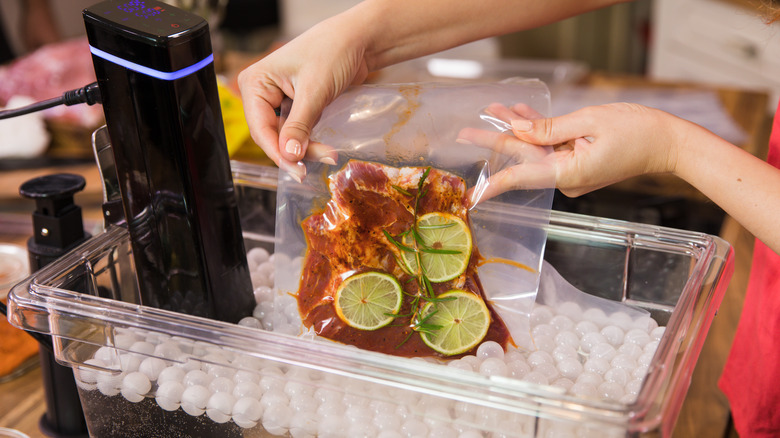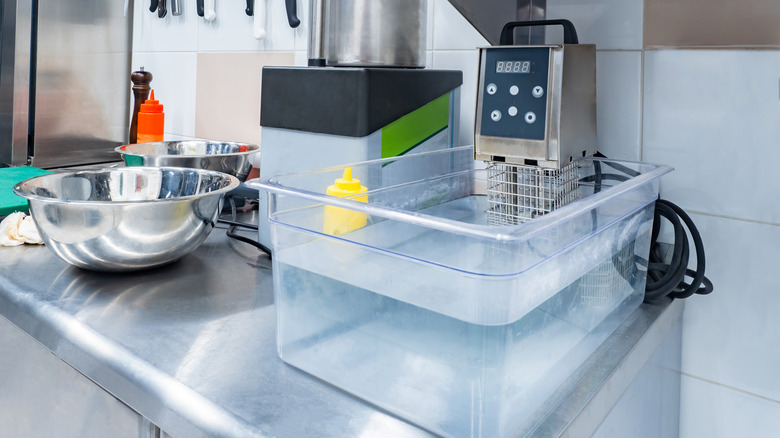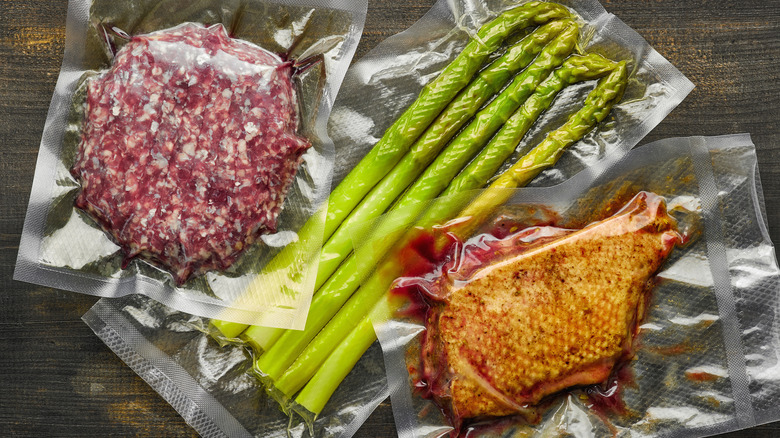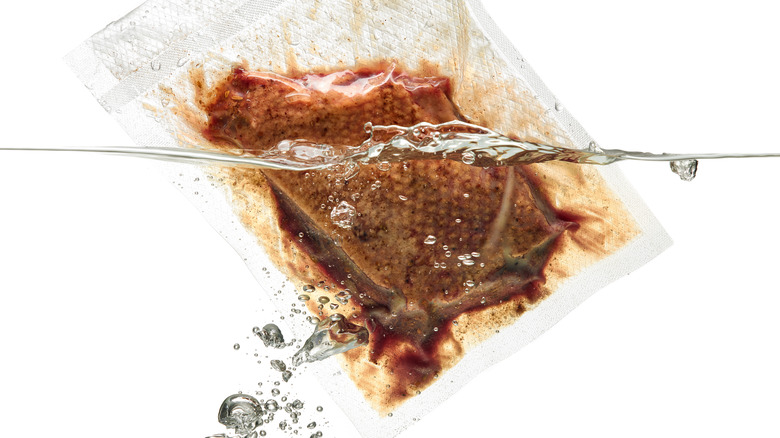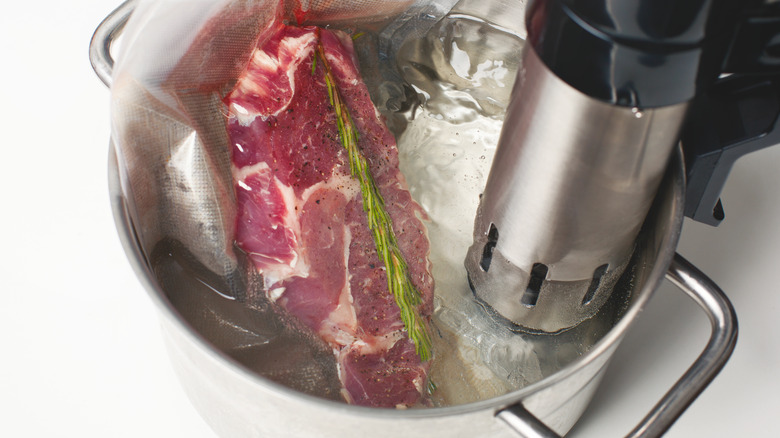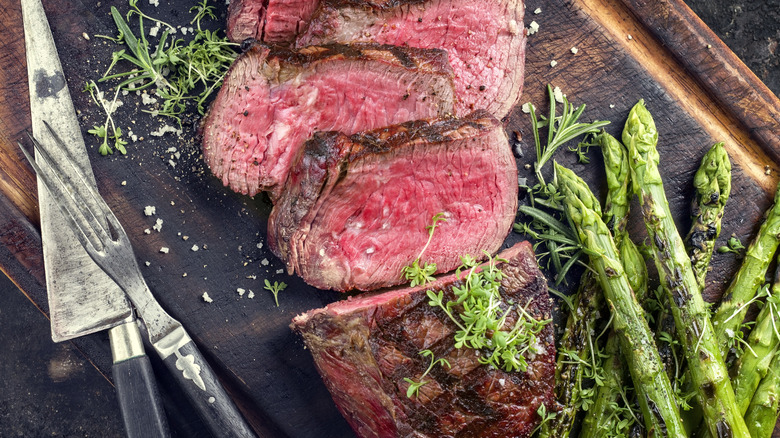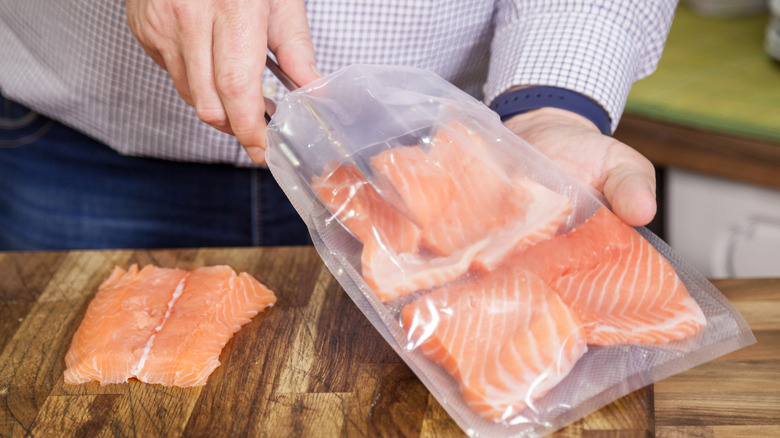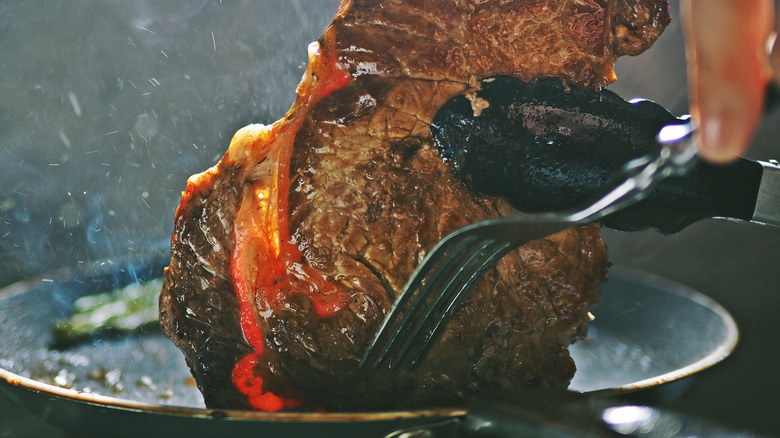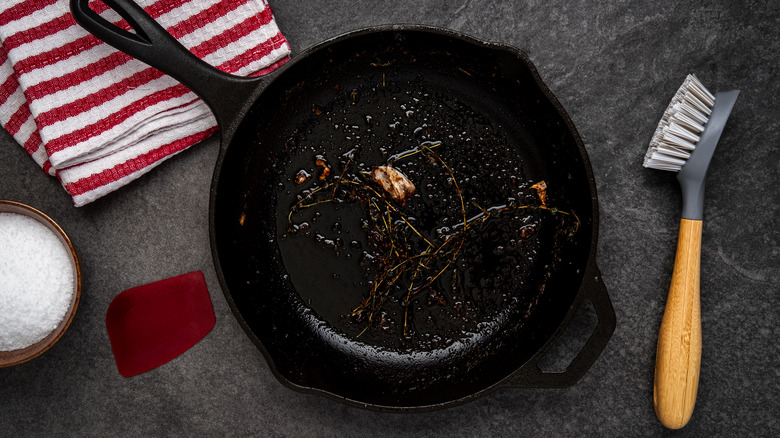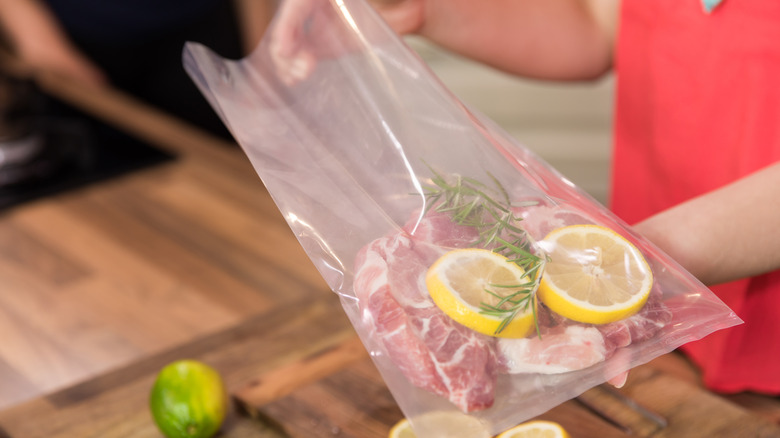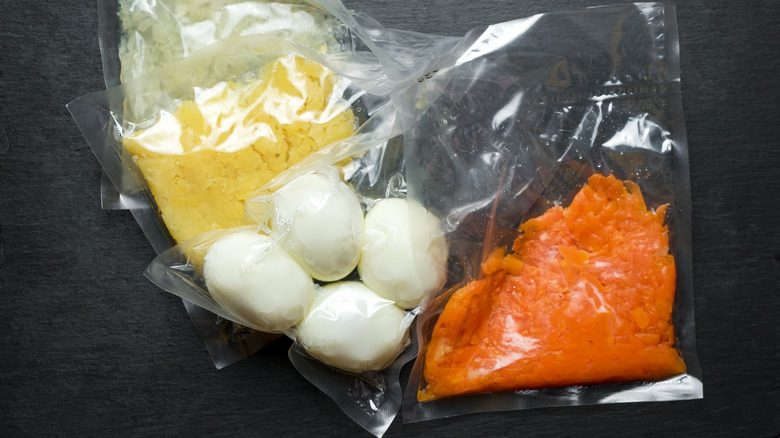10 Tips You Need When Sous Vide Cooking
The sous vide cooking method has taken the world of home cooking by storm over the past couple of years. As you may have heard, sous vide slow-cooks food in a water bath at a precise temperature set by the user. As Bon Appétit explains, the phrase "sous vide" translates to "under vacuum" in French, a reference to the process of vacuum sealing the food inside a plastic bag and then submerging that bag under the temperature-controlled water.
Though the origin of sous vide cooking often points to two French chefs, Bruno Goussault and George Pralus (both called the "father of sous vide"), in the 1970s, per NPR, the actual first sous vide may have been right here in the U.S., when a retired Army colonel named Ambrose McGuckian had the same idea of wrapping food in sealed pouches before submerging the food in water — in 1968. Incredibly, Col. McGuckian's story is far less known and the cooking method itself, while a sensation today, didn't quite take off in America until decades later.
As for sous vide cooking, it is, in a word, consistent: Fans say it yields more flavorful results, reduces waste, and grants more flexibility with time consumption and attentiveness. A cooking method that used to only be available to professionals can now be done in your own home, and here are some tips to help you do so.
Make sure you have the right tools
Before you try out your brand new sous vide machine, you have to make sure you have the necessary materials to do so. There are few bigger letdowns than researching a recipe, acquiring all of the ingredients you need, and then realizing you're missing an essential piece of equipment.
While a large stovetop pot may fit your immersion circulator, steel pots are not the most efficient temperature insulators, according to Serious Eats, and temperature insulation is the most important factor of sous vide cooking. A large, at least 8-quart plastic container is best for regulating your water temperature as well as providing enough room when cooking for a larger number of people.
Many sous vide recipes call for long cooking times. Therefore, you'll need the right type of bags to work with, ones with a secure enough seal that will last, like zipper lock freezer bags. This said, the most effective way to seal your ingredients is to use a vacuum sealer. They are certainly a monetary investment, but their quality, consistency, and longevity make it one worthwhile.
Once you submerge your sealed bag of whatever you're cooking, it is imperative for it to stay completely under water for the entirety of the cooking time. Per Serious Eats, this can be ensured using binder clips attaching the bag to the side of the container, or by placing several ping pong balls on top of the bag keeping it from resurfacing, a method that also helps minimize evaporation.
Start simple
Just like any other cooking method, practice makes purpose. When you're ready to start using your sous vide, it's best to begin with simple, straightforward recipes. Proteins like individual steaks, large cuts of pork, chicken breasts, and filets of fish like cod or salmon are good starting points that will help you get accustomed to the mechanism with a minimal learning curve and still awesome results.
While there are many sous vide recipes for delicate, leafy greens, they require more know-how, according to Sous-Vide Magazine. Instead, the outlet recommends beginning with larger, thicker root vegetables like carrots or asparagus and dense starches like potatoes or squash. Eventually, you can try to cook some greens. Cooks Illustrated declared sous vide to be the ideal cooking method for vegetables, so while veggies may be higher on the difficulty scale when it comes to sous vide, they are something to aim for as you continue to learn how to use the water bath for more than just proteins.
This said, the tip is to start simple; begin with ingredients you have cooked before. With a little practice, you'll have gained the confidence to take on unique and difficult recipes and uses.
Try the displacement method
If you don't have access to a vacuum sealer, the displacement method is your best friend. This technique is not only affordable, it will yield the same high-quality results as a vacuum sealer more often than not, according to Sous Vide Ways. Simply add your food and any marinades to a double-zipper Ziploc bag, a freezer bag, or a stasher bag. Zip the bag about 80% closed, leaving just the corner unzipped. Next, simply submerge the bag completely under water, gently massage away any pockets of air, and gradually lower the bag deeper into the water until the build up of pressure forces out all of the remaining air inside.
Then you can remove the bag and manually seal it shut. It is imperative that you completely seal the bag after removing the air. Food cannot be sous vide unless the bag is completely air tight. Although a quality vacuum sealer will ensure a 100% sealed bag every time, the water displacement method is likely a more accessible method for home cooks.
Don't be alarmed over air pockets
Despite using the right materials, it's still possible for air pockets to remain inside your sous vide bag. Should you find some air inside the bag while checking on your food, this does not automatically mean you have to stop cooking and start all over again, according to Home Kitchen Talk.
Air pockets are concerning because they create a barrier between the food and the cooking source; this air barrier is a particularly poor transfer agent of heat. If you are cooking the contents of your plastic bag for a longer period of time, some small air pockets shouldn't ruin your effort because everything will eventually reach a uniform temperature anyway.
With shorter times, however, air pockets will potentially prevent the heat from spreading throughout the food evenly, given the limited cooking time. One technique to help with air pockets is to rotate the bag multiple times throughout cooking. This will help distribute the heat more evenly. If you are still concerned about the evenness of the cook, you can take extra time, depending on the urgency of punctuality.
The only time a complete rebagging is necessary is if the air pockets are particularly large, the cooking time is very short, or the cooking temperature is very low. Accumulation of air pockets can occur if, for instance, a cut of meat is too large for its bag or is an irregular shape. If you do decide to rebag your food, try cutting the contents into smaller pieces and resealing more compactly.
Know what you're looking for
When starting any recipe, you have to have a clear understanding of the final product. If you don't, you'll just be following the steps of a recipe aimlessly. For example, perfectly cooked steak is very popular for sous vide. The sous vide will cook the steak for you, but the outcome does depend on your own personal preference. From rare to well-done, the scale of doneness should be understood and decided on before anything else takes place. The enjoyment of yourself and anyone sharing the meal with you really does depend on it.
The degrees of doneness for a steak using sous vide are as follows, according to Sous Vide Supreme: Rare is 120 degrees Fahrenheit, medium-rare is 135 F, medium is 140 F, medium-well is 150 F, and well done is 160 F and over. It should also be noted that most beef recipes will call for the cut to be seared in a pan after removal from its bag. Therefore, be sure to take this into account depending on what type of pan you have and the amount of rest time your recipe calls for. And again, this is only for steak as an example; other foods, including veggies and fruits, will require very different temperatures.
Remember you're still the one cooking
While the sous vide method removes a lot of the required attentiveness and skill for precision cooking, mistakes are still possible. Even though you set your desired, exact temperature, sous vide tools can still overcook your food. Yes, your water bath will reach and maintain a steady temperature, but leaving your food submerged too long can lead to an undesirable result.
As Epicurious cautions, a cut of meat cooked using sous vide but left submerged longer than the recipe calls for can become tacky and tough. Sous vide immersion circulators are not magic. They are a cooking tool that heats food just like an oven or stovetop. The temperature regulation does make for a more relaxed and casual cooking experience, but just like any other cooking method, any amount of cooking time longer than recommended will not yield the product you are looking for.
Dry your meat before searing
Even though many sous vide recipes call for any meat to be seared in a pan after cooking, this does not mean there isn't another important step in between, according to Amazing Food Made Easy. If you cook a steak to a precise temperature, you don't want the crust to be anything other than crisp and caramelized.
Completely removing any moisture from the outside of your meat will not only make for a great crust, it will help minimize the length of the sear, thus preserving the internal temperature. Any moisture on the outside of your meat has to first be boiled off, otherwise no browning can occur. If the moisture is removed entirely, the browning can start more quickly and the meat can leave the pan sooner.
One method to remove any moisture is to pat the meat with clean paper towels. You can also absorb any moisture with a dishcloth, just be sure to designate that cloth for that use only, and not use it for anything else. This is a good option because dishcloths are reusable and easily washed.
If cooking something with a skin on it like chicken wings, you can even refrigerate the cooked food uncovered overnight. Then, when it's time to eat, all that has to be done is a quick sear in a pan or placing under a broiler. No moisture will be spat out of the wings since it will have already evaporated.
Sear with cast iron (always)
As for searing sous vide foods, the best way to do this is in a cast iron skillet. Because cast iron is such a dense material, it is able to obtain and reserve high amounts of heat and distribute that heat evenly throughout the pan. According to Kitchn, evenly distributed heat makes for a deeper brown crust on a cut of meat and a more time efficient cooking of vegetables, all while not having to constantly manage heat source or rotating your pan to help certain parts of your food catch up to others.
This ability to hold a constant high temperature evenly across its surface is perfect for searing off your finished sous vide products because the sous vide has just cooked your food to a precise temperature. A final quick sear of that food in a pan with uneven and inconsistent heat distribution may end up overcooking the food in parts and the whole purpose of the sous vide will be defeated.
Plus, cast iron skillets are naturally nonstick and, when seasoned properly, add another layer of flavor to whatever it is cooking inside of it. Cast iron skillets are also very easy to clean and actually become a better product the more they are used.
Don't be wasteful
Sous vide cooking requires a lot of plastic and the bags used for sealing your food will often come into contact with raw meat. A disposal of the single-use plastic used for sous vide may be a clear and obvious choice, but what about being wasteful and the environment? Sous vide cooking actually requires much less energy than traditional cooking methods, according to Home Kitchen Talk. Furthermore, the plastic bags used for sous vide are recyclable.
There are even instances when sous vide bags can be reused, like when they are only used to contain raw vegetables, fruits, or sauces. If you do choose to reuse your sous vide bag, be sure to not only clean it but sterilize it. Per Foods Guy, an effective way to do so is to thoroughly scrub the bag with soap and hot water, and then fill the bag with one part bleach and 10 parts water. Let it soak for a couple of minutes and then rinse it out. Be sure to never allow the bleach solution to come in contact with and of your other sous vide equipment.
Another way to stay environmentally friendly is to reuse your sous vide bags creatively. After sterilizing, they can be used to keep baked goods fresh or to pack a lunch. You can even use your sous vide bags multiple times before filling it with raw meat, fish, or eggs. That way, your bag will have gotten multiple uses before recycling.
Consider new things
Once you have gotten familiar with your sous vide and have mastered the art of precise immersion cooking, there are endless options to try outside of the basic and sometimes redundant protein and vegetables. Practice with these simple, beginner recipes will give you a foundation of knowledge, and you can move on to preparing foods you never thought you could in your own kitchen.
For instance, sous vide eggs can be poached to perfection without the guessing games of boiling pots of water, and sous vide temper chocolate for professional patisserie-ready baking decorations. Another idea? Enhance your spirits by infusing them with your favorite flavor notes and have them ready to be sipped in just hours. Sous vides can whip up a custard without the painstaking task of bridging the line between thick enough eggs and scrambled ones. You can have pickled vegetables ready for your very next meal instead of one several weeks away.
What's more, your sous vide isn't limited to just heat regulation, but can also be used as a chiller. Instead of a messy, clunky ice bucket, drop your champagne, wine and beers in with a sous vide and keep all your libations frosty and chilled.
